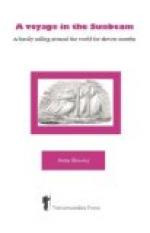From ivory carving, we went to a black-wood furniture shop, where we saw some very handsome things, by no means dear considering the amount of time and labour bestowed upon them. We finished up with the Temple of the Five Hundred Genii, whose five hundred carved wooden statues, thickly gilt, all very ugly, and all in different attitudes, stand round the statue of a European in sailor’s costume, said to be meant for Marco Polo, but, whoever it may be, evidently considered an object at least of veneration, if not of worship.
We now returned through the dirty city to Shameen, and the relief, after crossing the bridge into an open space where one could breathe freely and see the blue sky, was indescribable.
Friday, March 2nd.—Before we had finished breakfast the other gentlemen strolled in from their various quarters, and the drivers and guides arrived from the Vice-Consul’s. A long morning’s work had been mapped out for us—thirteen sights before luncheon, then a visit to the French Consulate, followed by eight more objects of interest to be seen before we finally crossed the Pearl River to visit the Honan Temple. Quitting the pretty cool suburb by another bridge, we passed through streets quite as dirty as those of yesterday, until the heart of the city had been reached. We went first to the wedding-chair shop, where they keep sedan-chairs, of four qualities, for hire whenever a wedding occurs. Even the commonest are made gorgeous by silver gilding and lacquer, while the best are really marvels of decorative art, completely covered with the blue lustrous feathers of a kind of kingfisher. In shape they are like a square pagoda, and round each tier are groups of figures. The dresses are also made of expensive feathers, but then they last for generations. There are no windows to these strange conveyances, in which the bride is carried to her future home, closely shut up, with joss-sticks burning in front of her. Recently there have been two sad accidents. In one case the journey was long, there was no outlet for the smoke of the joss-sticks, and when they arrived and opened the chair, the bride was found dead from suffocation. The other accident occurred through the chair catching fire while it was passing through some narrow street under an archway. The bearers became frightened, put down their burden, and ran away, leaving the poor bride locked up inside to be burnt to death.
From the chair shop we went to the embroiderers, to see them at work. Their productions are exquisite, and it is a pity that better specimens are not seen in England. The process of lacquer-making, too, is very interesting. We had, however, to go from house to house to witness it, as only one portion of the process is carried on at each—from the gradual coating of the roughest wood with three coatings of varnish, until it is finally ornamented with delicate designs, and polished ready for sale. In appearance, price, and length of wear there is a vast difference.




